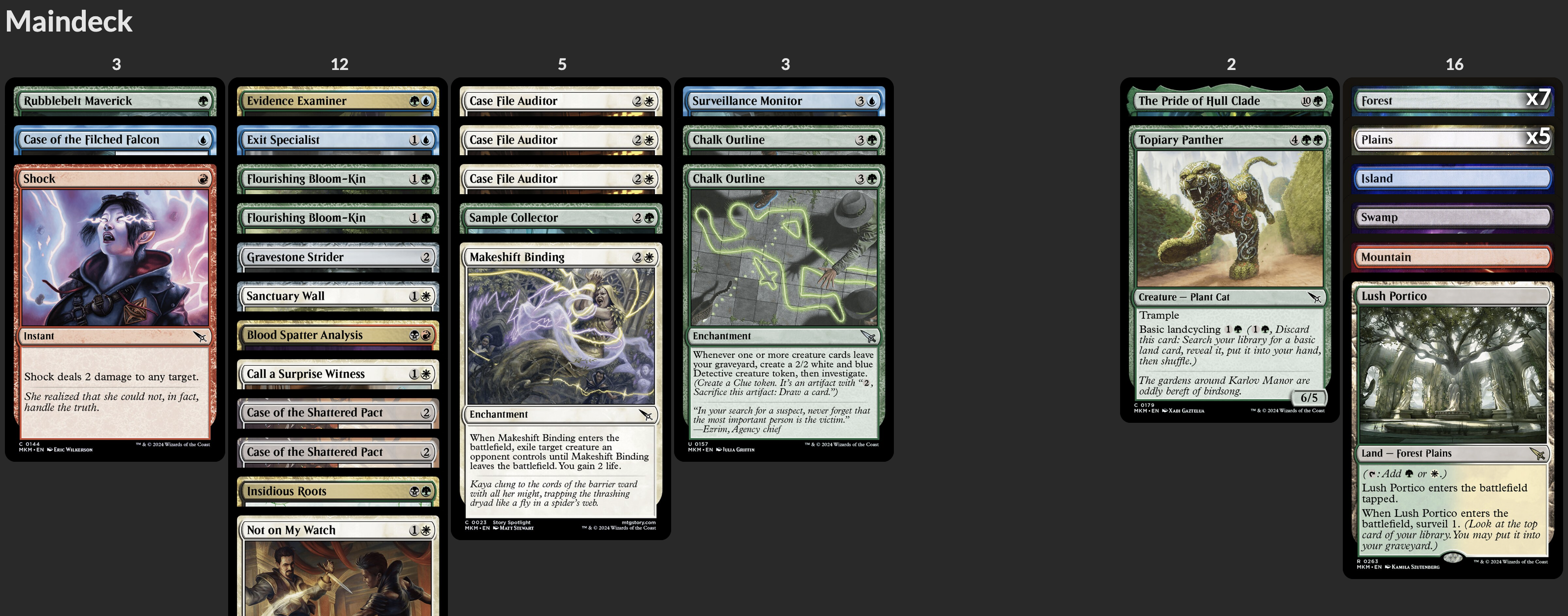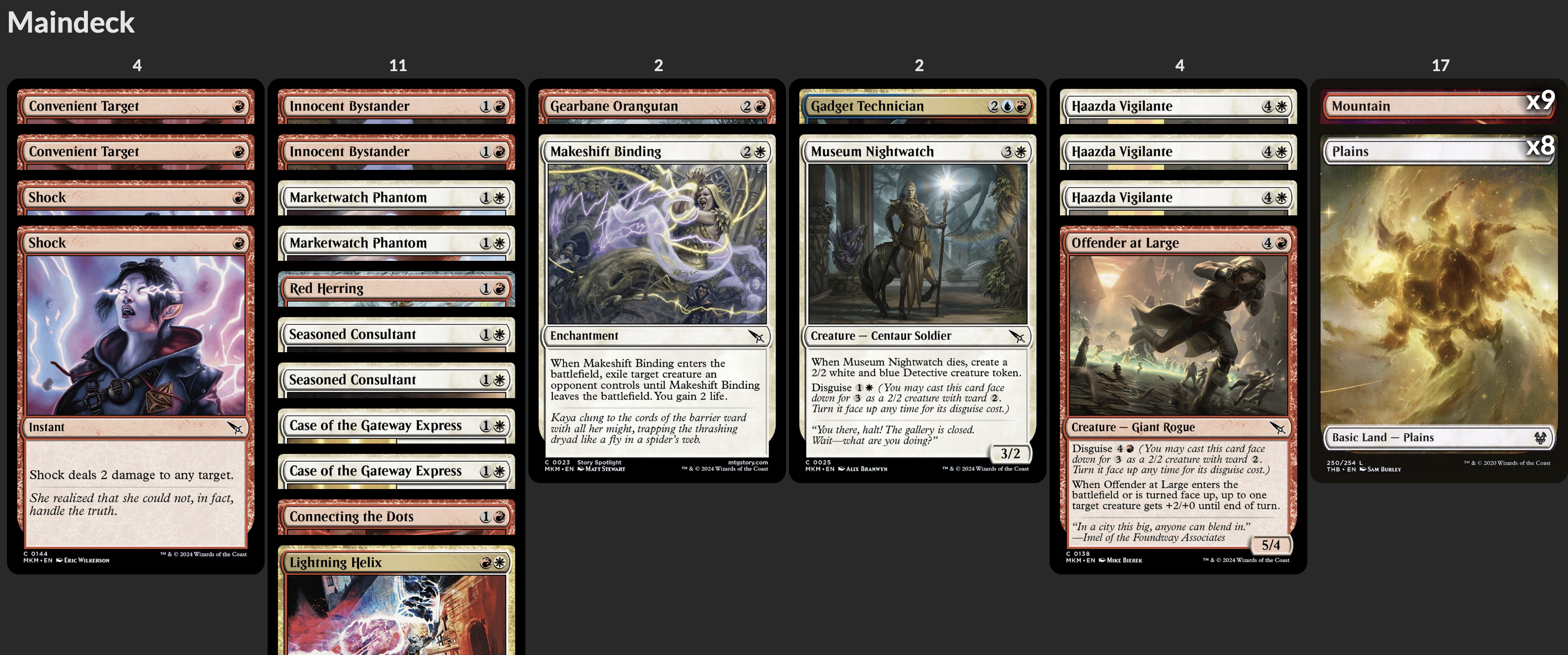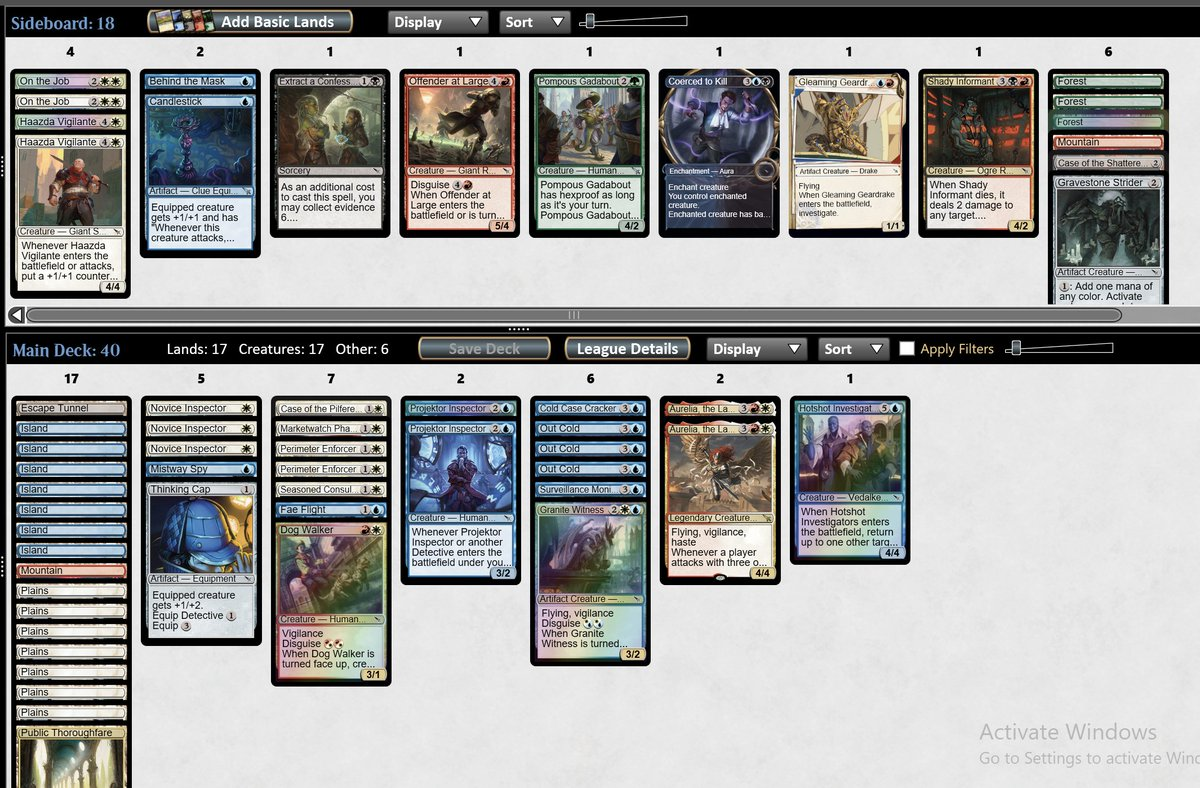Learning MKM: A Few Case Studies
02/09/2024
Early formats are always a fun time! But they aren't necessarily always much of a winning time for me. The start of the format is generally when I have the most 2-1s or 1-2s.
The reason for this is pretty simple: I value experimentation quite a lot (as you may have guessed from this blog's title). It's not just that I enjoy playing weird decks for the fun of it - though that's part of it too. But most importantly, in my experience experimentation is extremely important for actually learning a format deeply. I may be winning less now, but that's in service of winning more later!
So today, I figured I'd demonstrate some of my early experiments from these past few days, and show the fruits of my labor. For each case, I'll talk about why I made the choices I did, and the lessons I took away.
Case 1: Case of the Audited Chalk
We're starting off with a spicy one! This is a five-color deck, built around the card
Case File Auditor. Here's the Draft Log, Deck, and Games 1 2 3 4 5 6.
honestly shocked I got this draft 2, it's exactly what I wanted to try out most
Hypotheses - The Draft
First, let's go over some of more questionable choices I made during this draft, and talk about why I made them. Spoilers: the answer will generally be "to experiment!"
P1P1 up first! I didn't know if
The Pride of Hull Clade was a good pick, but I wanted to try out the mythic. I do this a lot early, and I highly recommend that you should too! If you don't know how good a card is, the best way to find out is to pick it and try it. This is especially important for weird rares and mythics, as you won't have very many chances to try them out if you pass up on them for the sake of safer picks.Sadly, I still don't know how good this card is. The only time I drew it this draft, I was already super far ahead, though it very technically gave me lethal that turn as an extremely expensive +1/+0 pump spell. Better luck next time, I guess!
P1P3: I took
Case of the Shattered Pact partially because I wanted to figure out how to draft multicolor decks, and also partially because I think a Simic deck playing Pride would be more likely to want to be multicolor.P1P5: for the record, I think that this is likely just the correct pick here. Case File Worker is an extremely strong card, and having one case already this early is a perfect time to pick it up. But I want to note that at this point, I'm basically already assuming that I'm going to force this deck for the sake of experimentation. That's probably not correct from a "trying to win" standpoint, but forcing is an important tool to experimenting - if you don't commit to the bit it's a lot harder to figure out what the bit looks like.
Chalk Outline, so of course at this point I'm trying to force that as well. And the P2P2 and P2P5 Case File Auditors really tell me that this is a draft where I am really testing what the extreme of case file auditing really looks like.
So the rest of the draft I pick up every single enchantment and creatures-leaving-the-graveyard enabler I can get my hands on. P2P7 is probably the most egregious pick here, as
Out Cold is a lot better of a card than Insidious Roots, but at this point I really just want to test the limits.One last note - P3P2 I specifically take
Rubblebelt Maverick over a second Case of the Shattered Pact because I expect - correctly! - that the case will wheel, and I want more leaves-the-graveyard enablers.Results
This deck went 1-2, winning its first match 2-0, and then losing the second and third matches 0-2 each. So what did we learn from that? Was it just variance? Were there specific awkward points?
Chalk: Seems Good
Well, first of all, Chalk Outline does in fact seem powerful enough to try build around. The games I lost were never because Chalk was too slow or too hard to trigger, but because of other inefficiencies in the deck. And there were quite a few games where it did quite a lot.
Takeaway/Future Work: Chalk seems powerful. More data needed on how best to maximize it.
Removal: Needed More
But speaking of the inefficiencies: one of the big ones was that I felt like I didn't have enough hard removal for a deck trying to go as long as this one. My deck really didn't have a way to pressure my opponent that quickly, so I found that sometimes I was just losing to singularly impactful cards in long games.
Here, for example, was a game where, while I did win, I could very much imagine just losing badly to Cryptic Coat if I didn't get aggressive quickly.
And then two of my losses were to just random large threats I couldn't deal with. This game I was never beating the Aurelia's Vindicator, but the 6/6 flier would've also killed me even if they didn't have the Vindicator; and this game I lost to Magmaw sticking on the board for 5 turns. It felt like just planning on gumming up the board, removing small creatures, and blocking wasn't enough for a deck like this - I really needed more copies of
Makeshift Binding and Dramatic Accusation to find with my Auditors.Takeaway: Decks looking to go long really need good grinding tools - which includes good removal.
Mana: Inefficient, Needed Impact/Ways to Catchup to Compensate
And finally, the mana was just not quite good enough here to keep up. It certainly wasn't unworkable by any means, but I felt like I didn't have enough ways to catch up from possible stumbling on mana early, and at the same time flooded out too much because I was playing too many cards like
Insidious Roots and Case of the Filched Falcon that were blank when I was flooding.The 2 mana land cycling from Case of the Shattered Pact and
Topiary Panther didn't seem terrible, but I think I would now categorize them as a bit subpar.Takeaway: Lands,
Nervous Gardener, and Gravestone Strider are meaningfully better fixing than Case and Panther.And I think I need to avoid trying to fit quite as much nonsense in decks in the future.
Takeaway: If I'm going to be playing a multicolor soup deck that might need to run more effective lands for color reasons, I need all the cards to actually be impactful.
Case 2: Case of the Forced Boros

not the most coherent deck
This case is fairly different than the previous one. It looks like just somewhat normal, if mediocre, Boros deck - but a lot of the mediocrity is from me making intentionally weird choices.
So, here's the Draft, Deck, and Games 1 2 3 4 5 6 7 8.
Hypotheses
The Draft
The main decision I made this draft was that, after I had two
Case of the Gateway Express and one Connecting the Dots by P1P3, I decided I wanted to test what happens if I roughly forced Boros from there.So I took some perhaps questionable picks, like a P1P4
Crime Novelist over Private Eye.I also felt that the entire draft I needed to have more creatures for the cards I had that really cared about going wide with creatures, so I made some picks to support that, like P2P1 taking
Marketwatch Phantom over Shock.Deckbuilding Choices
This time I also made a couple interesting deckbuilding choices for the sake of experimentation.
Namely, I decided to play all three copies of
Haazda Vigilante in order to better figure out how good that card is, and also played two copies of Convenient Target instead of any of my three copies of Auspicious Arrival to collect data on that as well.I don't think that either of these choices was necessarily "correct" for the deck - Arrival is a generally pretty strong card, and three may have been too many Vigilantes - but again, I wanted to get more experience with cards I hadn't yet played with.
Results
This deck also went 1-2, losing its first two matches 1-2 and then winning the last one 2-0. Where did this one go wrong?
Not Wide Enough
Because I started off with three enchantments that all wanted me to play many creatures to the board, I focused a lot during the draft on making sure I had enough cheap creatures. But sadly, I basically never saw anything that added two things to the board at the same time - no
Dog Walker, no Inside Source, no Person of Interest, and no Novice Inspector. The only such effect I saw were two copies of Gadget Technician, and I only took one of them.But because I was lacking in cards that made multiple pieces of cardboard, it felt really difficult to enable my cards that cared about going wide. I had plenty of 2 drops - 7 in total! But those by themselves just weren't enough.
Takeaway: Go-wide decks really rely on enablers that contribute multiple bodies to the board; perhaps even more so than the payoffs.
Perhaps I should've Dog Walker over Case of the Gateway Express pack 1 pick 1.
Vigilantism is... Okay
Haazda Vigilante played out completely fine, but also not that exciting. It felt like the kind of card that could sometimes take over the game, but other times be kind of mediocre
This also somewhat ties into the previous point - it felt pretty good when I had an already-wide board of small creatures, but quite bad when my board was small. And this deck wasn't that great at maintaining those wide boards, as discussed.
Takeaway: Haazda Vigilante feels somewhat powerful, but not without risk - probably okay to play a couple copies as your topend, but not a draw to anything by itself.
Inconvenient Targets
Finally,
Convenient Target always felt okay, but also never felt amazing. It certainly helped push damage, but compared to Auspicious Arrival, it didn't really have as impactful of an effect on the game.Notably, Arrival causes a swing in material - you win a combat and get a clue generally, which in some senses is like playing a copy of the creature that won the combat and getting a clue. Convenient Target, on the other hand, just gives that creature menace in a way that the opponent can still trade with. So it naturally leads to smaller games on your side, especially because it doesn't investigate.
I also never used the ability to return Convenient Target to my hand from my graveyard, which is pretty telling. I just didn't have good opportunities to want to trade off my menace creature and then give another creature menace.
Perhaps it would've been better in combination with Arrival - then I could maybe force some good menacing blocks. But I also had pretty limited space for noncreatures, so it's unclear how I could've fit both that well. Almost certainly it was better to play only Arrivals.
Takeaway: Convenient Target seems like an okay card for pushing damage, but works against the gameplan of wanting bigger, wider boards. Auspicious Arrival is a lot more suited to the Boros gameplan.
Case 3: Case of the Cold Proof

The second Aurelia here is somewhat fake, due to an MTGO bug. I kept forgetting to change my deck between rounds so I played it in all game 1s, but sided it out every time because without the bug I would only have one.
This is probably the most normal-looking deck out of all of these (or put another way: the best one). But still, there were a couple of interesting experimental points to it.
This was a league draft on MTGO, so I don't have quite as extensive logs of it that I can share. But here's the draft, at least.
Hypotheses
The main thing I was testing with this deck was whether
Case of the Pilfered Proof was a card worth building around.I didn't really have to warp my draft or deckbuilding around this - the P1P8 case I got was even just pretty free itself, and my deck naturally fell into UW detectives for other reasons. And I did try a bit to maximize how many detectives I was playing, but all my detectives were good cards anyways.
The second thing I was testing here was whether three copies of
Out Cold could serve as a sufficient replacement for removal (which this deck notably lacks). I could've opted to splash black for Extract a Confession and Coerced to Kill instead of splashing red for Aurelia, the Law Above, but decided I wanted to see if the Out Colds were sufficient.I also could've taken more interaction during the draft - most notably a couple copies of
Sudden Setback in my P2P2 and P3P1 - but I decided I wanted to see if I could do without.Results
This deck went 2-1, losing 1-2 to a good RW deck, winning 2-1 against a good UR deck, and then winning 1-0 (with my opponent conceding the match) against a mediocre RB deck.
Pilfering the Proof of Novice Inspectors
Case of the Pilfered Proof felt extremely good in this deck. Specifically, with the amount of card flow I had access to between three copies of
Novice Inspector and two copies of Projektor Inspector, I felt like I could both consistently solve the case and consistently keep the flow of detectives going to get lots of counters.The extra counter also felt like it mattered a lot - the difference between a 1/2 and a 2/3 for Novice Inspector specifically is pretty huge, and it was very nice on the fliers I had too.
On top of that, the extra clues I got when it solved did come up quite a bit! With three copies each of Novice Inspector and Out Cold, the extra clues meant that I was able to meaningfully chain those together, and hence never ran out of things to do.
All in all, I think that this case is a powerful one, but also very narrow - you have to have a lot of detectives, have a lot of card flow to keep getting value from the counters, and ideally also have a way to take advantage of its solved state, though that seems less necessary. And Novice Inspector happens to fit all three of these conditions perfectly.
Takeaway: Case of the Pilfered Proof is strong but narrow, and the best enabler is Novice Inspector. The second best is probably Projektor Inspector - the important part is having a steady stream of detectives, as the +1/+1 counters are actually quite impressive.
Out Cold is Hot (Mostly)
Out Cold felt mostly extremely good - 2 turns of tapping 2 things is just a lot. It felt extremely backbreaking whenever I was the aggressor, and that was very often the role I was taking in my matches.
That said, there was one specific problem with it - it performed fairly poorly against RW go-wide decks, and was some of the reason why I lost my first match to RW. There just wasn't ever really an opportunity that I felt it was impactful enough to spend 4 mana on, and didn't quite stem the bleeding enough.
So, I'm not sure if you can actually solely rely on Out Cold as your interaction. Though to be fair most traditional removal that UW has wouldn't line up well either.
Takeaway: Out Cold is extremely strong, and is great interaction against any deck that isn't going wide.
Cases Closed
So there we have it - three cases, three very different decks, and all with some useful conclusions to take into future drafts.
Hopefully this served as a good demonstration of the process and utility of experimentation. And hopefully, it inspires you to experiment more yourself!
#FreePalestine | Consider donating to UNWRA or PCRF, supporting protesters locally, and educating yourself.
